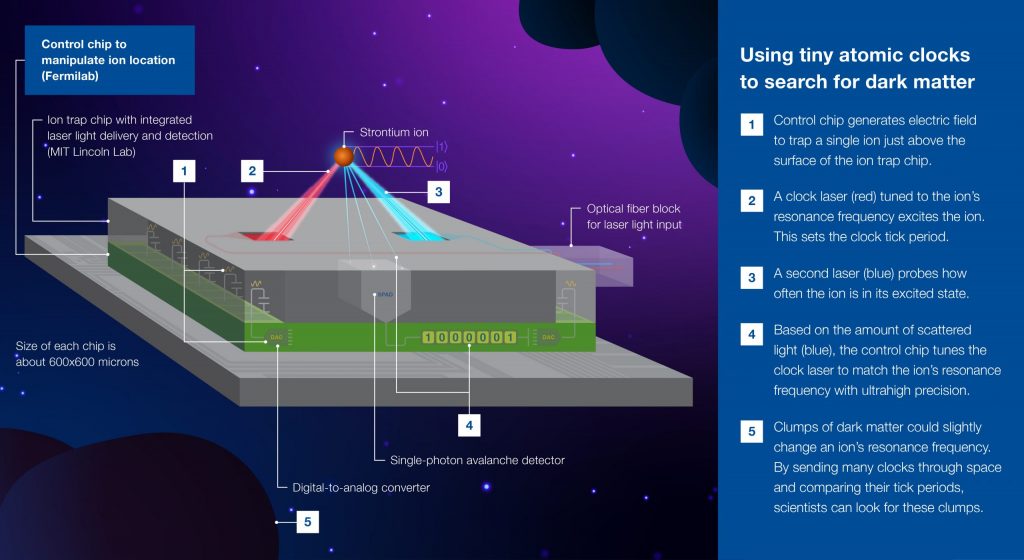In 2021, amid the COVID-19 pandemic, two instruments, each approximately the size of two refrigerators, arrived at the U.S. Department of Energy’s Fermi National Accelerator Laboratory in Batavia, Illinois. The first landed in March, the second in December.
They were amplifiers — the first prototype units of what will become the power source for Fermilab’s new linear particle accelerator. A team of scientists and engineers at India’s Raja Rammana Centre for Advanced Technology, or RRCAT, designed, developed and built both of them for the Proton Improvement Plan II, or PIP-II, project at Fermilab.
But with the pandemic restrictions on international travel, Indian scientists could not accompany their work to the United States. Instead, engineers at Fermilab had to install the amplifiers with guidance “over the phone,” said Jim Steimel, PIP-II sub-project manager for high-power radiofrequency at Fermilab. The tight cooperation between the teams ensured the successful installation, despite the challenges of remote coordination.
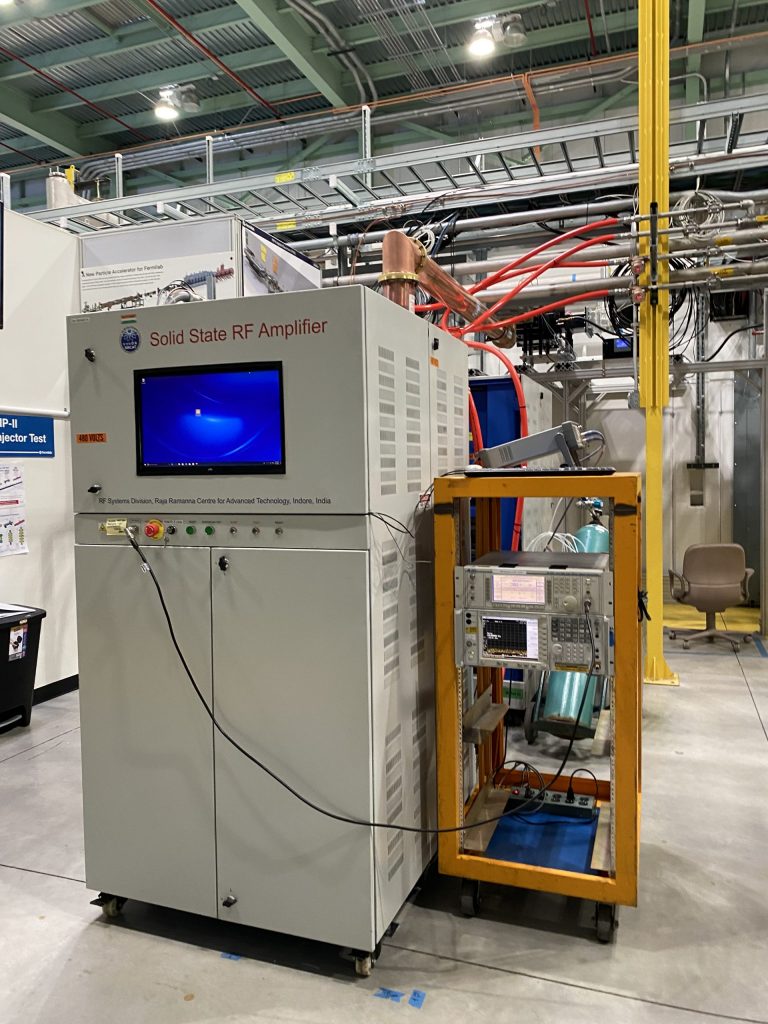
Scientists at RRCAT in India developed and built this prototype 40-kilowatt solid-state radiofrequency amplifier for PIP-II before shipping it to Fermilab for testing. Photo: Madeleine O’Keefe, Fermilab
It’s one example of the strong collaboration between the U.S. and India in high-energy physics and accelerator research. Now, with travel restrictions loosened, a few representatives from the Indian PIP-II team have made their way to Fermilab to — finally — see their work in action.
An important partnership
India is an important scientific partner for the United States. Recently, in mid-June, Prime Minister Narendra Modi of India and United States President Joe Biden met at the White House to deepen bilateral cooperation between the two countries on cutting-edge scientific infrastructure. As part of the agreement, India will supply components worth $140 million to the PIP-II project. This contribution was even highlighted in this White House statement (see number 10).
The Indian Department of Atomic Energy institutions have a strong partnership with Fermilab. In February 2023, DOE’s Asmeret Berhe took her maiden visit to India as the director of the Office of Science. Invited by the chairman and the secretary of DAE, Berhe participated in meetings with officials at the U.S. Embassy, as well as India’s Ministry of External Affairs, the Bhabha Atomic Research Centre and Tata Institute of Fundamental Research. The tour included a visit to the University of Chicago Delhi Center. She also met with institutional leaders who work on high-energy physics programs, with a specific emphasis on accelerator programs.
Accompanying Berhe on the visit was a cohort that included Gina Rameika, associate director for the DOE Office of High Energy Physics; Lia Merminga, Fermilab director; Josh Inaba, special assistant, Office of Science; Daniel Schwab, science and technology policy advisor, Office of International Science and Tech Cooperation and Trusted Research, Office of Science; and Hema Ramamoorthi, Fermilab director for international engagements.
PIP-II is the first particle accelerator to be built in the U.S. with significant contributions from international partners. In addition to India, the PIP-II project will receive in-kind contributions from institutions in France, Italy, Poland and the United Kingdom. India’s deliverables include superconducting acceleration structures, electromagnets and radio-frequency power sources that will be fabricated in India and then transported to the U.S. for installation.
Pioneering new technology with PIP-II
PIP-II’s new accelerator will power the world’s most intense beam of neutrinos. It will provide the beam for the Deep Underground Neutrino Experiment, hosted by Fermilab. Over the course of its 215-meter length, the accelerator will drive particles to nearly 85% the speed of light through five different types of accelerating cryomodules.
The linear accelerator uses superconducting radio-frequency technologies to power the particle beam. SRF technologies enable much more efficient particle acceleration than conventional technologies; however, they also require ultracold temperatures to operate. So, the cryomodules house strings of cavities — ranging from three to eight — in liquid helium baths and layers of insulation that isolate the cavities from the “warm” room temperature. PIP-II has 116 cavities distributed among 23 cryomodules.
“I think it is important that they are able to visit the laboratory and see their product in action.” – Jim Steimel, PIP-II sub-project manager for high-power radiofrequency at Fermilab
PIP-II uses five different types of SRF cavities, with each type designed to efficiently accelerate particles of a particular velocity. “Every cavity requires a radiofrequency source to accelerate the beam,” said Steimel. The power to maintain the beam varies based on the cavity.
PIP-II uses three different radio frequencies to power the beam. As the beam gets narrower farther down the accelerator, they use shorter-wavelength frequencies to compress the beam further.
“We need to generate the RF necessary to keep the field in those cavities,” said Steimel.
So the accelerator uses amplifiers that magnify the radiofrequency signal and send it into the cavities. Different amplifiers operate at 7 kilowatts for the first stage of acceleration, 20 kilowatts for the second, 40 kilowatts for the third and up to 70 kilowatts for the final stage. Engineers designed these amplifiers based on solid-state RF amplifier technology, or SSAs.
Making valuable contributions
Institutions in India will supply all the hardware for the SRF cavity amplifiers. The Bhabha Atomic Research Centre in Mumbai will provide amplifiers for the lower-energy single-spoke resonator cryomodules. So far, they have sent nine 325-megahertz 7-kilowatt amplifiers, which Fermilab tested in beam operations.
Meanwhile, RRCAT will provide amplifiers for the 650-megahertz cryomodules: 36 of the 40-kilowatt and 24 of the 70-kilowatt types. The amplifiers sent during the pandemic were prototypes of a 32-kilowatt and 40-kilowatt amplifier to be used for testing. (PIP-II will not use a 32-kilowatt amplifier in the accelerator, but it was sent as a prototype for proof of concept.)

From left to right: Deepak Sharma and Alok Gupta (both from RRCAT), David Peterson, James Steimel, Victor Grzelak and Patrick Sheahan (from Fermilab) stand in front of the prototype 40-kilowatt amplifier for Fermilab’s PIP-II particle accelerator. Photo: Niral Patel, Fermilab
Each amplifier is made up of dozens to hundreds of 500-watt amplifier modules, called power amplifiers, or PAs. The large magnitude of modules required for assembly—ranging from 96 to 232 PAs per amplifier—make the amplifiers extremely complex.
“RF amplifiers are really delicate and complex equipment. After commissioning in PIP-II, they will be operated for 20 years,” said Deepak Sharma, a scientific officer at RRCAT. “So, this is a highly important task for both institutions.”
Sharma is one of the two Indian scientists visiting Fermilab to work on the amplifiers. He arrived in early May, overlapping with fellow RRCAT scientific officer Alok Gupta who arrived in February and departed mid-May. Sharma’s stay will last approximately three months. It is the first visit to the United States for the scientists, both of whom were on the RRCAT team that developed the amplifiers in India.
“I think it is important that they are able to visit the laboratory and see their product in action,” says Steimel. “They’re seeing how this is actually working in operation: They’re watching the operators using it, trying to keep the field up in the cavities. They’re getting feedback from the people that are operating it in terms of possible issues with control and stability.”
The prototype 32-kilowatt amplifier initially encountered some issues during testing. So, Gupta set up a test stand to measure, qualify and repair the PAs for 650-megahertz SSAs. After two months of work with Fermilab engineers, Gupta reported the amplifier now functions reliably.
Sharma has continued working on improving the amplifier design while on site. He and Gupta will take those improvements and bring them back to RRCAT to be considered for the next set of designs based on updated requirement specifications. “These improvements will be incorporated in final sets of the amplifiers as prototype amplifiers were based upon earlier requirements,” said Gupta. “So, we will be working on the newer designs at our lab at RRCAT.”
The RRCAT team is currently prototyping improved amplifier subsystems for PIP-II. The final design review for the 40-kilowatt amplifier is tentatively scheduled for September; in the meantime, RRCAT will conduct their own internal reviews.
In a few years, when the PIP-II team is ready to assemble the entire accelerator, Gupta and Sharma hope to return to Fermilab with their team to install their amplifiers — in person, this time.
Fermi National Accelerator Laboratory is supported by the Office of Science of the U.S. Department of Energy. The Office of Science is the single largest supporter of basic research in the physical sciences in the United States and is working to address some of the most pressing challenges of our time. For more information, please visit science.energy.gov.
In the search for dark matter — the mysterious, invisible substance that makes up more than 80% of matter in our universe — scientists and engineers are turning to a new ultra-sensitive tool: the optical atomic clock.
These clocks, which measure time by using an ultra-stable laser to monitor the resonant frequency of atoms, are now precise enough that if they ran for the age of the universe, they would lose less than one second. That stability also enables these devices to act as extremely sensitive quantum sensors that could be deployed into space to search for dark matter.
The challenge: The equipment required to operate such ultra-precise clocks — including lasers, electronics and coolers — can fill a large table or even a room. It would make launching them into space very expensive if not impossible.
Scientists working on a joint U.S. Department of Energy and Department of Defense project aim to miniaturize these elements to the size of a shoebox. After more than two years of work, the researchers — from the DOE’s Fermi National Accelerator Laboratory and the Massachusetts Institute of Technology Lincoln Laboratory — have reported initial promising results.
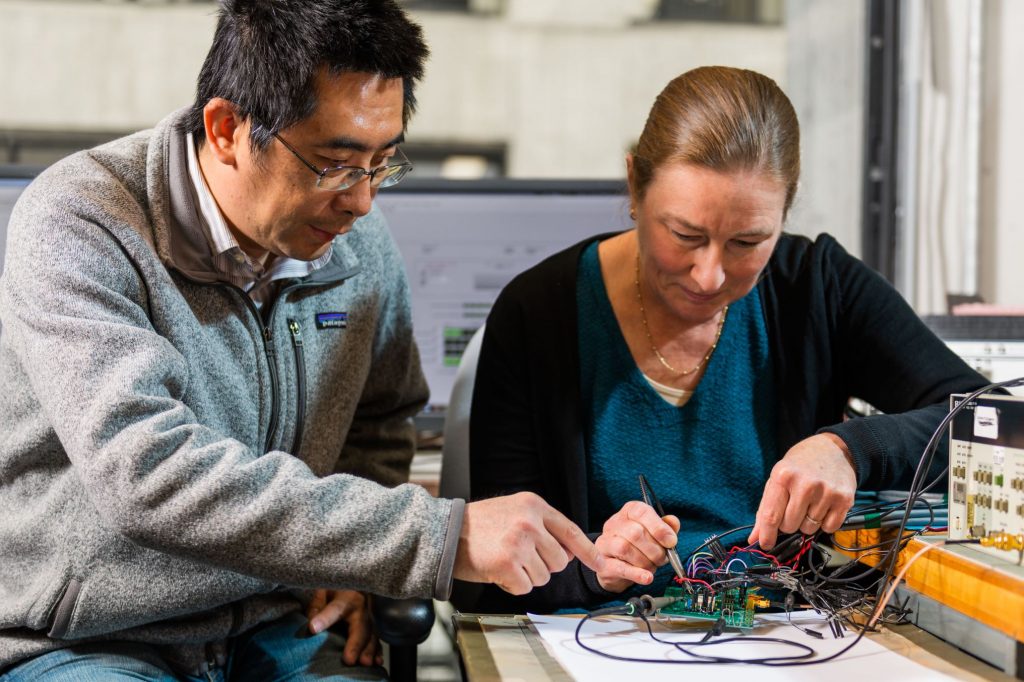
Fermilab researchers Hongzhi Sun and Pamela Klabbers test the chip at the test stand. Photo: Ryan Postel, Fermilab
Fermilab researchers designed and developed the compact electronics needed to control the voltages within the device, while MIT LL researchers are developing the tiny ion traps and corresponding photonics needed to build the clock. The chip designed by the Fermilab team is currently under testing at MIT LL.
“This is the first step toward a high-accuracy, small footprint atomic clock,” said Fermilab Microelectronics Division Director Farah Fahim, who leads the project for the lab.
A new way to detect dark matter
MIT LL’s optical atomic clock uses an ion trap as a sensor — in this case, a Strontium ion that is confined by an electrical field. A laser acts as the clock’s oscillator, measuring the oscillation frequency of the ion’s transition between two quantized energy levels.
This sort of compact atomic clock could be ideal for deployment to space to search for ultralight dark matter, which is theorized to cause oscillations in the masses of electrons. If several atomic clocks traveled through a clump of dark matter in space, the dark matter could increase or decrease the photon energy measured by each clock, changing how it “ticks.” The clocks would desynchronize as the dark matter passes and resynchronize thereafter.
Researchers conducted these experiments with GPS satellites, which each contain multiple atomic clocks based on a different technology. But they found no evidence for dark matter in these experiments. Perhaps, the researchers considered, dark matter could be detected with a more sensitive clock.
Funded by the DOD, MIT LL researchers have miniaturized the trapped-ion atomic clock, integrating laser delivery and detection all onto one chip. But to complete the system, MIT LL researchers needed more than just miniaturized atomic and photonic components. They needed help designing a miniature electronic control system. That’s where Fermilab came in; DOE’s high-energy physics QuantISED program funded the electronics development and integration.
“We have more than 30 years of experience developing compact electronics for collider physics, and we have developed chips for extreme environments,” Fahim said. “That’s not unlike the electronics needed for controlling atoms and reading out their state.”
“It’s a project that really leverages the unique capabilities of different government laboratories,” said Robert McConnell, staff scientist at MIT LL who led development of the photonic ion trap chip for the project.
Integrating compact electronics with the ion trap
The difficulty lies in creating a small chip that can control the high voltages needed for the system — at least 20 volts — while both retaining high speed and utilizing low power. Working with a semiconductor manufacturer, the Fermilab team recently created a chip that could control up to nine volts. “It also has low voltage noise, so it won’t perturb the quantum state of the ion,” said Hongzhi Sun, the lead chip designer on the project.
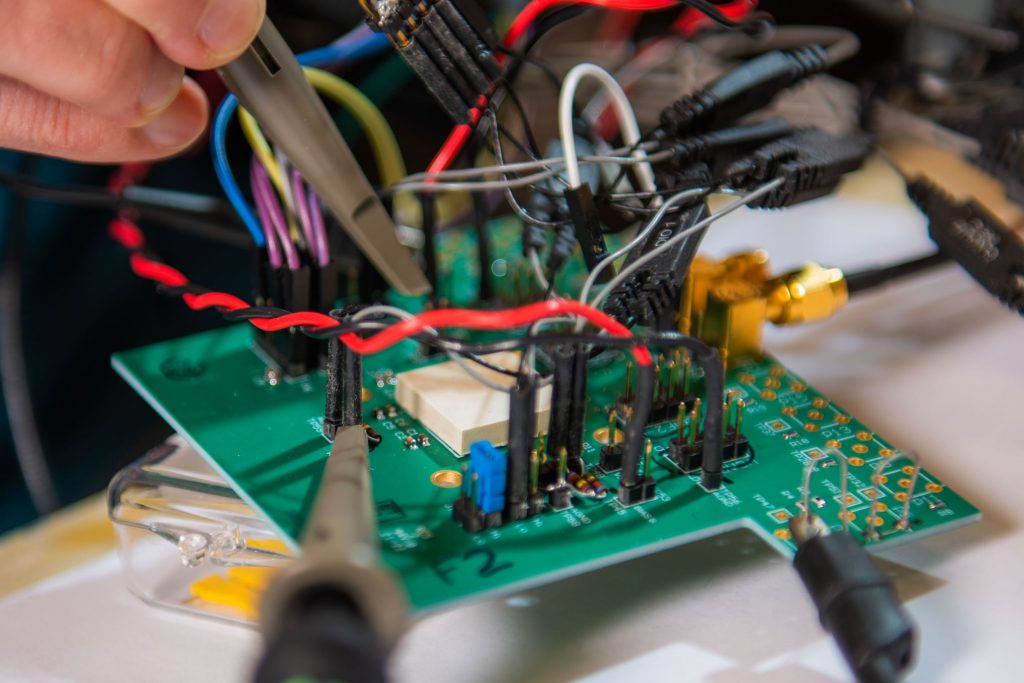
Ready for testing: The chip’s custom test board is connected the test equipment. The chip is wire-bonded to the board and protected by the square white plastic cap. Photo: Ryan Postel, Fermilab
MIT LL researchers now look to integrate the chip with the ion trap through a technique that allows them to stack the two chips on top of each other and connect them through vias, or electrical connections between layers. Fermilab researchers will then continue to hone the electronics design to increase the voltage up to 20 volts. The goal is to create a compact atomic clock with frequency uncertainty of 10-18.
Other applications
“This collaboration allows us the benefits of both worlds,” said McConnell. “By having Fermilab design circuits and integrating them with our ion traps, we can create well-controllable quantum sensors.”
The clocks could be used beyond high-energy physics research, including in space defense or even as extremely sensitive sensors that could predict tsunamis or earthquakes. These ion traps could also form the basis for future quantum computers.
“There is a great disparity in the application goals for DOD and DOE but an equally compelling synergy in the underlying technology development; we simply need to find ways to work together,” Fahim said.
Fermi National Accelerator Laboratory is supported by the Office of Science of the U.S. Department of Energy. The Office of Science is the single largest supporter of basic research in the physical sciences in the United States and is working to address some of the most pressing challenges of our time. For more information, please visit science.energy.gov.
Scientists working on the Dark SRF experiment at the U.S. Department of Energy’s Fermi National Accelerator Laboratory have demonstrated unprecedented sensitivity in an experimental setup used to search for theorized particles called dark photons.
Researchers trapped ordinary, massless photons in devices called superconducting radio frequency cavities to look for the transition of those photons into their hypothesized dark sector counterparts. The experiment has put the world’s best constraint on the dark photon existence in a specific mass range, as recently published in Physical Review Letters.
“The dark photon is a copy similar to the photon we know and love, but with a few variations,” said Roni Harnik, a researcher at the Fermilab-hosted Superconducting Quantum Materials and Systems Center and co-author of this study.
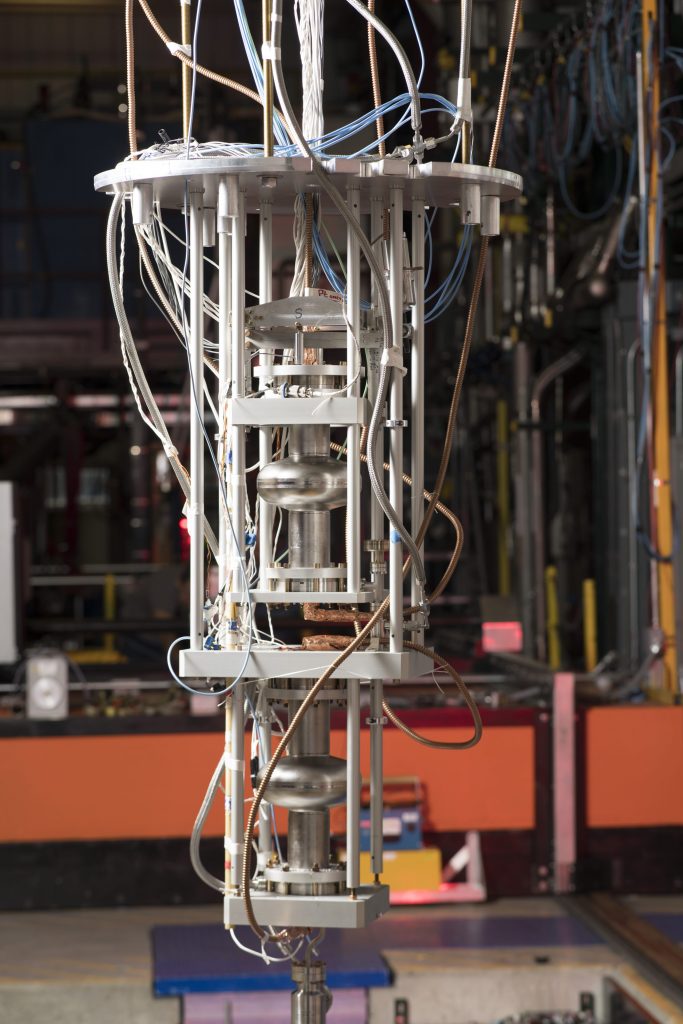
The Dark SRF experiment demonstrated unprecedented sensitivity by using two SRF cavities as the key components for experiment. Photo: Reidar Hahn, Fermilab
Light that allows us to see the ordinary matter in our world is made of particles called photons. But ordinary matter only accounts for a small fraction of all matter. Our universe is filled with an unknown substance called dark matter, which comprises 85% of all matter. The Standard Model that describes the known particles and forces is incomplete.
In theorists’ simplest version, one undiscovered type of dark matter particle could account for all the dark matter in the universe. But many scientists suspect that the dark sector in the universe has many different particles and forces; some of them might have hidden interactions with ordinary matter particles and forces.
Just as the electron has copies that differ in some ways, including the muon and tau, the dark photon would be different from the regular photon and would have mass. Theoretically, once produced, photons and dark photons could transform into each other at a specific rate set by the dark photon’s properties.
Innovative use of SRF cavities
To look for dark photons, researchers perform a type of experiment called a light-shining-through-wall experiment. This approach uses two hollow, metallic cavities to detect the transformation of an ordinary photon into a dark matter photon. Scientists store ordinary photons in one cavity while leaving the other cavity empty. They then look for the emergence of photons in the empty cavity.
Fermilab researchers in the SQMS Center have years of expertise working with SRF cavities, which are used primarily in particle accelerators. SQMS Center researchers have now employed SRF cavities for other purposes, such as quantum computing and dark matter searches, due to their ability to store and harness electromagnetic energy with high efficiency.
“We were looking for other applications with superconducting radio frequency cavities, and I learned about these experiments where they use two copper cavities side-by-side to test for light shining through the wall,” said Alexander Romanenko, SQMS Center quantum technology thrust leader. “It was immediately clear to me that we could demonstrate greater sensitivity with SRF cavities than cavities used in previous experiments.”
This experiment marks the first demonstration of using SRF cavities to perform a light-shining-through-wall experiment.

Standing around the Dark SRF experiment from left to right are SQMS Center Director Anna Grassellino, SQMS Science Thrust Leader Roni Harnik and SQMS Technology Thrust Leader Alexander Romanenko. Photo: Reidar Hahn, Fermilab
The SRF cavities used by Romanenko and his collaborators are hollow chunks of niobium. When cooled to ultralow temperature, these cavities store photons, or packets of electromagnetic energy, very well. For the Dark SRF experiment, scientists cooled the SRF cavities in a bath of liquid helium to around 2 K, close to absolute zero.
At this temperature, electromagnetic energy flows effortlessly through niobium, which makes these cavities efficient at storing photons.
“We have been developing various schemes trying to handle the new opportunities and challenges brought in by this ultra-high-quality superconducting cavities for this light-shining-through-wall experiment,” said study co-author Zhen Liu, an SQMS Center physics and sensing team member from the University of Minnesota.
Researchers now can use SRF cavities with different resonance frequencies to cover various parts of the potential mass range for dark photons. This is because the peak sensitivity on the mass of the dark photon is directly related to the frequency of the regular photons stored in one of the SRF cavities.
“The team has done many follow-ups and cross-checks of the experiment,” said Liu, who worked on the data analysis and the verification design. “SRF cavities open many new search possibilities. The fact we covered new parameter regions for the dark photon’s mass shows their successfulness, competitiveness and great promise for the future.”
“The Dark SRF experiment has paved the way for a new class of experiments under exploration at the SQMS Center, where these very high Q cavities are employed as extremely sensitive detectors.” said Anna Grassellino, director of the SQMS Center and co-PI of the experiment. “From dark matter to gravitational waves searches, to fundamental tests of quantum mechanics, these world’s-highest-efficiency cavities will help us uncover hints of new physics.”
Fermi National Accelerator Laboratory is supported by the Office of Science of the U.S. Department of Energy. The Office of Science is the single largest supporter of basic research in the physical sciences in the United States and is working to address some of the most pressing challenges of our time. For more information, please visit science.energy.gov.

